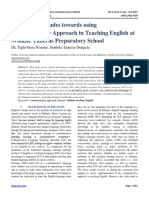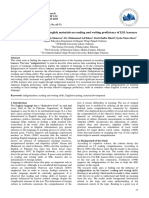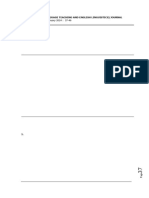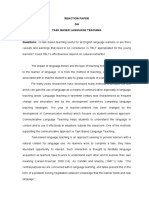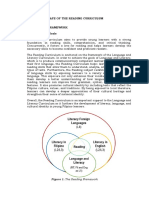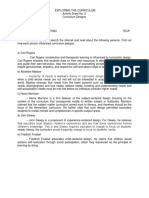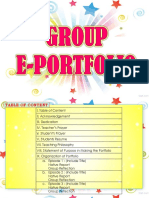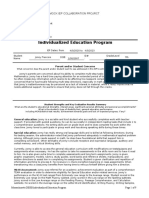2018 Jurnal SALTEL
2018 Jurnal SALTEL
Uploaded by
Fauzi MiftakhCopyright:
Available Formats
2018 Jurnal SALTEL
2018 Jurnal SALTEL
Uploaded by
Fauzi MiftakhCopyright
Available Formats
Share this document
Did you find this document useful?
Is this content inappropriate?
Copyright:
Available Formats
2018 Jurnal SALTEL
2018 Jurnal SALTEL
Uploaded by
Fauzi MiftakhCopyright:
Available Formats
Southeast Asia Language Teaching and Learning (SALTeL) Journal
Vol.1, No.2, July 2018, pp. 27~ 31
ISSN: 2614-2684 27
Intercultural Teaching and Learning English through Reading
Skill
Fauzi Miftakh1
1
Universitas Singaperbangsa Karawang
Article Info ABSTRACT
Article history: In this globalization era, teaching English has to also involve
Received Mar 20, 2018 intercultural aspects in order that students can develop their
awareness towards the differences of the culture of the target
Revised May 26, 2018
language. The intercultural teaching and learning English can be
Accepted Jun 20, 2018 corporated with reading skill activities as suggested by Usó-Juan &
Martínez-Flor (2008). This study was a qualitative study which
potrayedreading activities to assist intercultural teaching and learning
Keywords:
English. The data were taken with observation of teaching learning in
Intercultural Teaching the classroom with 25 students of 2nd semester at a state university in
Reading Karawang, West Java. 6 students were also selected to have interview
English in order to know their response and understanding. Finaly, there were
some reading activities, such as critical reading and cultural bump,
conducted in the classroom that could quite effectively improve the
students’ intercultural awareness. Some students also responded by
giving positive statements about reading skill activities so their
intercultural understanding could improve. However, implementing
these activities were not an easy task because the teacher needs to
understand the theoritical concept of intercultural language learning
Corresponding Author: Fauzi Miftakh, Lecturer at Universitas Singaperbangsa Karawang, email:
miftakh.fauzi@yahoo.co.id
Copyright © Association of Language Teachers in Southeast Asia.
All rights reserved
1. INTRODUCTION
English language teaching now has also incorporated with intercultural communicative competence. The
students are not only taught English language itself but also they are taught how to communicate with other
people from different backgrounds or culture effectively and appropiately in many ways. In addition,
intercultural English teaching is also important for students to make them become an intercultural persons.
As we know that in English language teaching itself, there are four skills that have to be mastered by students
namely speaking, writing, listening and reading skill. The last one mentioned is an important skill that should
be learned by students so that they can be a good and critical students especially in seeing differences among
cultures. Therefore, intercultural English learning is very possible to be brought with reading skills. It can
improve students’ reading skill while they also learn other cultures and make them aware how to use
language aproppiately.
As suggested by Usó-Juan & Martínez-Flor (2008), intercultural English learning can be incorporated with
the four skills of English including reading skill. There are many ways of teaching intercultural English with
reading skill to be performed in the classroom. In addition, teaching reading allows students to read various
texts such as texbooks, newspaper, magazine, and etcetera. However, Gomez (2012) suggests that EFL
learners should not entirely acquire language through textbooks, but also through the use of authentic texts.
Authentic text can be an appropiate text to be read by students especially because it contains wider and
various informations. Specifically in intercultural English learning, the most important thing is that the
teacher is possible choose appropiate which consists of cultural contents. It will be vey useful as media in the
reading class.
Furthermore, there are some researchers who also conducted similar relevant studies in field of intercultural
English learning with reading skills in recent years. The previous studies include a study by Gomez (2012)
that focuses on intercultural communicative competence through reading authentic literary text. The other
studies were conducted by Nie (2017) concerning intercultural study through novel reading, Sharp (2010)
Journal of ALTSA (www.altsacentre.org)
28 ISSN: 2614-2684
dealing with intercultural rhetoric and reading comprehension, and Yehezkel & Devora (2017) that carried
out a topic about reading comprehension through intercultural competence in multicultural classroom. These
studies have given the researcher some influential ideas and knowledge to also conduct a study especially in
Indonesia context.
Furthermore, based on the background and previous studies above, this study tries to answer the following
research questions:
A. How are the students’ reading activities in intercultural English learning?
B. Howare the students’ responses to learning reading activities?
2. LITERATURE REVIEW
2.1. Intercultural language learning
Language and learning are terms that have corelation. In intercultural language learning, language and
learning are fundamentally interrelated concepts. Intercultural language learning is not only about how to
teach a language, but also it involves newer and richer ways to connect languages to other learning areas.
Liddicoat et al. (2003: 46) mention that intercultural language learning involves the fusing of language,
culture and learning into a single educative approach. It begins with the idea that language, culture and
learning are fundamentally interrelated and places this interrelationship at the center of the learning process
(2003:46).
In terms of learning, students engage in developing cultural competence from the beginning of their language
learning (Crozet et al, 1999). Liddicoat et al. (2003) also add that intercultural language learning involves
developing with learners and understanding of their own language and culture in relation to an additional
language and culture. Liddicoat et al. (2003) explain that at a global level the goals of intercultural language
learning are as follows.
1. Understanding and valuing all languages and cultures
2. Understanding and valuing one’s own language and culture
3. Understanding and valuing one’s target language and culture
4. Understanding and valuing how to mediate among languages and cultures
5. Developing intercultural sensitivity as an ongoing goal.
The goal of learning is to ‘decenter’ learners from their pre-existing assumptions and practices and to develop
an intercultural identity through engagement with an additional culture. Jokikokko (2009) adds that, for a
teacher, important intercultural competences are, for instance, the ability to take students’ various cultures,
languages, backgrounds and abilities into account in teaching and learning.
Thus, teachers are responsible to make the learners understand their own culture before exploring the target
culture (Valverde: 2005). As a process of developing intercultural understanding, students need to beable
to‘decenter’ from their own culture (Byram, 1989). In language learning, this decentering takes two forms:
decentering from one’s own language and culturein communicating with others and decentering in the
processes of teaching and learning.
2.2. Intercultural English learning through reading activities
Basically, there are three main stages in conducting intercultural English learning as suggested by Usó-Juan
& Martínez-Flor (2008) that are explanation, collection and implementation. It is formulated based on the
framework of communicative competence that includes five components namely, discourse, linguistic
pragmatic, intercultural competence and strategic. The stages are to help teachers tackle cultural aspects in
the language classroom especially through four skills of English. There are some samples of reading
activities in intercultural English class as suggestd by Usó-Juan & Martínez-Flor (2008). including critical
reading, cultural bump activities, activities that focus on written genres or cultural extensive reading.
Critical reading. In this activity, students are given text and they make judgments about how the text is
argued. It is abeneficial reflective activity type for promoting learners’ intercultural competencewhile
practicing the reading ability. In carrying out this activity, the generalframework based on pre-, during-, and
post-reading instruction could be of help.
Teachers can also make learners read situations in which there is a cultural bumpthat is, a situation that cause
people to become uncomfortable or strange give particular cultural beliefs and attitudes. Then, different
written interpretations of thebehavior of the people involved in the situation can follow the account in a
multiplechoice format to allow class discussion and subsequently, check whether learnershave correctly
interpreted what went wrong and why people acted as they did, whichwill definitively help learners become
aware and understand behavior in a targetculture (Williams 2001).
SALTeL Vol. 1, No. 2, July 2018: 27 – 31
SALTeL ISSN: 2614-2684 29
Learners could also be required to analyze two written texts which have a similargenre as for example,
reading advice columns in daily newspapers but which arefrom different cultures in order to compare if
concerns and debates vary betweencultures (Williams 2001). The sentences of a cultural anecdote could be
scrambled by the teacher and thenlearners could be requested to put the anecdote in sequence. This activity
type is auseful one in order to help learners discern organizational issues in a given text(Celce-Murcia and
Olshtain, 2000).
All material gathered by the learners in the second stage of the project could serveas the basis to prepare
additional activities that make learners develop in activatingall competencies of the communicative
competence construct. Word associationactivities where learners associate words in a given text to a given
cultural topiccould be helpful to promote learners’ linguistic competence. Analysis of the textdevices that
convey the intended meaning of a given cultural text could serve topromote learners’ pragmatic competence.
Furthermore, the practice of previewing ormaking guesses about the content of a given cultural text both
before and whilereading could work to develop learners’ strategic competence.
3. METHODS
This is a qualitative study that investigates students’ reading activities that is incorporated with intercultural
English learning and the students’ response to the teaching and learning activities. There are 25 students of
second semester at a state university in Karawang taken as participants. Two technique of colecting data were
carried out including observation and interview. Observation was done to potrait the teacher and students’
activities in teaching and learning intercultural English incorporate with reading skill, while interview was
conducted to get more information about students’ responses after leraning intercultural English with reading
skill. Six students were choosen to be representative in interview. The data were analyzed qualitatively
through thematic analysis (Braun & Clark, 2006). Furthermore, the data taken from various techniques
including observations and interviews were gathered to be identified and analyzed thematically and later to
be displayed and made a conclusion.
4. RESULTS
This result and discussion are based on the research questions mentioned in the previous chapter, namely: A)
How are the students’ reading activities in intercultural English learning? and B) How are the students’
responses to learning reading activities?Accordingly, there are two main findings taken from the data.
4.1. Students’ reading activities in intercultural English learning
The data finding shows that there are various intercultural reading activities performed in the teaching and
learning process. The text used as authentic media is entitled “How American parenting is killing the
American marriage” that was taken from https://qz.com/273255/how-american-parenting-is-killing-the-
american-marriage/. This text is an argumentative text, so the students may have different perspective in
discussing it. Critical reading activity was done in the classroom. There were three main steps in this activitiy
that are pre-, during-, and post-reading instruction. In the pre-reading activity, students were asked to
determine the content of the reading by previewing the passage and then judge whether the identified content
can be a representative of their own culture.
At first, they said that basically the American culture is different with Indonesian culture especially in
marriege and parenting although there may be similarities too. The students were also asked how they could
know the American’s marriege and parenting whether on internet, movies, magazine or friends, and they
discussed it with the teacher. During reading activity, the students red the whole text and identify the cultural
differences of American and Indonesian marriege and parenting. They also discussed the topic with their
friend and made a list of findings based on their reading. They compared their findings with other students
and discussed it again. The teacher sometimes became facilitator and gave clarifications towards the
students’findings. Finally, in post-reading activity, the students were asked why there are some differences
between American and Indonesian marriege and parenting, and what they should do towards the differences.
The teacher did reflection with the students to summerize their reading. It is the most important part in
intercultural learning where the students should be taught to be a responsible person who aware of and
respect differences as well as do not judge other cultures as wrong altough it is different with theirs.
In the second meeting, the text used was entitled “Developing a social life in the USA” taken from
https://www.internationalstudent.com/study_usa/way-of-life/social-life/. It is a text that tells about how
students live in American college especially for international students. A cultural bump activity was done,
that is, a situation that cause people to become uncomfortable or strange give particular cultural beliefs and
attitudes. As usual, three main steps were conducted that are pre, during, and post reading. In pre-reading
activity, students were asked to identify the content of the reading by previewing the passage and compare
SALTeL Vol. 1, No. 2, July 2018: 27 – 31
30 ISSN: 2614-2684
the content between their own culture and the target culture. Students provided different statements towards
the topic that was about American social life.
In during-reading activity, students red the whole text and discussed with their friends. They might find some
interesting and strange culture that happen in American social life especially in making friends. The teacher
then provided some situations that required students’ responses in order to know what should theu do in the
situation where there are as non-native people of American culture. The situations were vary such as
responding an invitation to a perty, being introduced to a new friend, and inviting someone for dating. The
students wrote their responses and the also refered to the text they had read before. The students discussed
their answers with the teacher and the teacher checked whether students have correctly interpreted what went
wrong and why people acted as they did. It helped students to become aware and understand behavior in a
target culture.
4.2. Students’ responses to learning reading activities
Students’ responses were taken from interviews with 6 representatives. Basically, students provided positive
comments to the intercultural reading learning process. It gave them new experience and challenges in
learning English. To know the students’ responses from interview, the followings are sample of students’
answer.
Do you like learning English with its culture?
S1 : I like it so much because it is interesting to know other culture.
S2 : It is a new thing of learning English for me because I was also taught the culture of English (target
culture) and I like it.
Do you like the reading activities in intercultural English?
S3 : This reading activities were fun and interesting especially in cultural bump activity.
S4 : I like it, especiallt the text provided by the teacher is interesting. It is about social life in America.
Do you feel that your reading skill is improved?
S5 : Actually, I do not really think that my reading skill is improved a lot, maybe because I only
focused on the cultural issue on the text. But I believe it will give me more ability.
S6 : Yes, I feel I can read the content quite well and I understand the content so I can discuss with other
friends and the teacher too.
How do you see cultural differences in the reading? Do you think it is wrong or not?
S1 : I do not think it is wrong, because they have their own way to do something. It is their culture, and
we should respect to them.
S2: : There is nothing to judge as wrong because we have different habit, so I think they are different
because it is their habit.
Based on students’ response above, there are four important points to discuss. The first, they like to learn
English with its culture because it is interesting and they found it as new thing. The second, Reading
activities perfomed in the teaching and learning Intercultural English were fun and interesting too. Students
are interested to the texts given by teacher and cultural bump activity. The third, Students still think that their
readign skills are not significantly improved because they just performed the activities in two meetings.The
forth is the students show that they become more aware and respect to differences of other cultures. The most
important thing is they do not judge other cultures wrong although some habit and values are different with
their own culture.
5. CONCLUSION
Based on the research questions, there are two conclusions that can be taken in this study. The first, Students’
reading activities in intercultural English learning were vary including critical reading and cultural bump.
These activities provided more opportunites for students to be critical students in viewing differences of other
culture. The texts used also supported the learning activities since they were taken in authentic sources. The
second, students’ responses towards the learning reading activities were positive. They said that they got new
ways of learning reading that is interesting and fun especially the cultural bump activity. However, they still
think that their reading skills are not significantly improved because they just performed the activities in two
meetings. And the most important thing is that they have shown positive attitudes to become persons who are
aware of differences and also respect them. Finally it is suggested to other teachers to also use this kind of
activities in order to give students different opportunities and challanges in learning English especially
reading activities. And it is better for teachers to also understand the theoritical concept of intercultural
language learning.
SALTeL Vol. 1, No. 2, July 2018: 27 – 31
SALTeL ISSN: 2614-2684 31
REFERENCES
Braun, V. and Clarke, V. (2006) Using thematic analysis in psychology. Qualitative Research in Psychology,
3 (2), 77-101.
Byram, M. (1989). Cultural Studies in Foreign Language Education. Clevedon, England: Multilingual
Matters.
Celce-Murcia, Marianne and Olshain, Elite (2000): Discourse and Context in LanguageTeaching. A Guide
for Language Teachers. Cambridge: Cambridge University Press
Crozet , C., Liddicoat , A.J. & Lo Bianco, J. (1999). Intercultural competence: From language policy to
language education. In J. Lo Bianco, A. Liddicoat& C. Crozet (eds), Striving for the third place:
Intercultural competence through language education. Melbourne: Language Australia, pp. 1-20.
Envisage International Corporation. (2012). Developing a Social Life in the USA [online]. Available at:
https://www.internationalstudent.com/study_usa/way-of-life/social-life/
Gomez, L. F. (2012). Fostering Intercultural Communicative Competence Through ReadingAuthentic
Literary Texts in an Advanced ColombianEFL Classroom: A Constructivist Perspective. PROFILE,
14(2), 49-66.
Jokikokko, K. (2009). The role of significant others in the intercultural learning of teachers. Journal of
Research in International Education. 8 (2), p. 142-163.
Liddicoat, A.J., Scarino, A., Papademetre, L., & Kohler, M. (2003). Report on intercultural language
learning. Canberra: Commonwealth Department of Education, Science and Training.
Nie, Y. (2017). Facilitating Intercultural Study through Novel Reading - The Application of Reading Task
Journals.Theory and Practice in Language Studies, 7(6), 436-442.
Sharp, A. (2010). Intercultural Rhetoric and Reading Comprehension in a Second Language. Reading
Psychology, 31, 472–491.
Williams, Mary (2001): ‘It must be cultural because I don’t do it”: Cultural awareness ininitial TESOL
teacher education”. In M. Byram, A. Nichols, and D. Stevens, eds.,Developing Intercultural
Competence in Practice. Clevendon: Multilingual Matters, 111-129.
Yehezkel, H & Devora. (2017). The path to reading comprehension through intercultural competence in the
multicultural EFL classroom.Language & Intercultural Communication, 17(3), 323-343.
Valverde, G. (2005). Communication, culture and language teaching. RevistaPensamiento Actual, 5(6), p. 92-
98.
Teller, D. (2014). How American parenting is killing the American marriage [online]. Available at:
https://qz.com/273255/how-american-parenting-is-killing-the-american-marriage/
Uso-Juan, E. & Martinez-Flor, A. (2008). Teaching Intercultural Communicative Competencethrough the
Four Skills. Revista Alicantina de Estudios Ingleses, 21, 157 - 170
SALTeL Vol. 1, No. 2, July 2018: 27 – 31
You might also like
- Sarah Wengerter Master Research Proposal 2015Document20 pagesSarah Wengerter Master Research Proposal 2015api-315705429No ratings yet
- English For Specific PurposesDocument7 pagesEnglish For Specific PurposesEmenheil Earl EdulsaNo ratings yet
- Curriculum Book FinalDocument62 pagesCurriculum Book FinalAnonymous YRCL8ceSNo ratings yet
- CAL - Peru - Participant - Hand-Out - August 27 Webinar PDFDocument20 pagesCAL - Peru - Participant - Hand-Out - August 27 Webinar PDFKristinaNo ratings yet
- Jurnal Nasional ELT in Focus - Fauzi MiftakhDocument10 pagesJurnal Nasional ELT in Focus - Fauzi MiftakhFauzi MiftakhNo ratings yet
- Learners' Attitudes Towards Using Communicative Approach in Teaching English at Wolkite Yaberus Preparatory SchoolDocument13 pagesLearners' Attitudes Towards Using Communicative Approach in Teaching English at Wolkite Yaberus Preparatory SchoolIJELS Research JournalNo ratings yet
- Using All English Is Not Always Meaningful'Document6 pagesUsing All English Is Not Always Meaningful'Erjin PadinNo ratings yet
- Impact of Indigenization of English Materials On Reading and Writing Proficiency of ESL LearnersDocument8 pagesImpact of Indigenization of English Materials On Reading and Writing Proficiency of ESL LearnersRuqqia AmirNo ratings yet
- Argyro Kanaki in PressDocument23 pagesArgyro Kanaki in PressargyroNo ratings yet
- English Education Journal: p-ISSN 2087-0108Document20 pagesEnglish Education Journal: p-ISSN 2087-0108Umi KulsumNo ratings yet
- 37-46 NazarDocument10 pages37-46 NazarAnnisaNo ratings yet
- JPSP 2022 393Document15 pagesJPSP 2022 393Junalyn Villegas FerbesNo ratings yet
- Fushino, K (2011) Students' Reactions To A Group Project in A University EFL Class For Cultural UnderstandingDocument17 pagesFushino, K (2011) Students' Reactions To A Group Project in A University EFL Class For Cultural UnderstandingJoel RianNo ratings yet
- TEL_Volume 18_Issue 2_Pages 1-34Document34 pagesTEL_Volume 18_Issue 2_Pages 1-34Eghosa AlariNo ratings yet
- An Analysis of Students Speaking Ability On SpeciDocument8 pagesAn Analysis of Students Speaking Ability On SpeciHarun Al RasyidNo ratings yet
- Articol CLT BunDocument10 pagesArticol CLT BunLoredana ScarlatescuNo ratings yet
- Yohana and ProsperyDocument21 pagesYohana and ProsperybapropskNo ratings yet
- 17 Nurlia y Arini Effect of Bringing Local Culture in EnglishLanguage Teaching On Students' WritingAchievementDocument8 pages17 Nurlia y Arini Effect of Bringing Local Culture in EnglishLanguage Teaching On Students' WritingAchievementLaura PrezNo ratings yet
- LLLLDocument2 pagesLLLLRafael Brix AmutanNo ratings yet
- Patunob Manuscript QaDocument109 pagesPatunob Manuscript Qajanebriana46No ratings yet
- IntegritasDocument35 pagesIntegritasIvan MaulanaNo ratings yet
- Teaching Strategies and Literature Learning in The Public Secondary Schools Along The K To 12 CurriculumDocument11 pagesTeaching Strategies and Literature Learning in The Public Secondary Schools Along The K To 12 CurriculumPsychology and Education: A Multidisciplinary JournalNo ratings yet
- Cross Cultural Knowledge Ho Chi MinDocument17 pagesCross Cultural Knowledge Ho Chi MinArlan V. PayadNo ratings yet
- English Language Teachers' Experience in Teaching English Among The Struggling Junior High School StudentsDocument25 pagesEnglish Language Teachers' Experience in Teaching English Among The Struggling Junior High School StudentsPsychology and Education: A Multidisciplinary JournalNo ratings yet
- Intercultural Aspects in Teaching Indonesian As A Foreign Language (Bipa)Document11 pagesIntercultural Aspects in Teaching Indonesian As A Foreign Language (Bipa)Jennet SenawatiNo ratings yet
- Chinese University English-Major Students AttitudDocument18 pagesChinese University English-Major Students AttitudPrince CuetoNo ratings yet
- 1 PBDocument12 pages1 PBkntarash08No ratings yet
- Comparative Paper AnalysisDocument4 pagesComparative Paper AnalysisjassieNo ratings yet
- A Study On The Application of Task-Based Language TeachingDocument10 pagesA Study On The Application of Task-Based Language TeachingArafat ShahriarNo ratings yet
- READINGDocument14 pagesREADINGretno wulan sariNo ratings yet
- Chapter II REVIEW OF RELATED LITERATURE MaicaDocument13 pagesChapter II REVIEW OF RELATED LITERATURE Maicachleo marie dosdosNo ratings yet
- Lyndy Mae TitlesDocument10 pagesLyndy Mae TitlesJoey SuanNo ratings yet
- Factors Affecting English Language Teaching and Learning in Higher EducationDocument12 pagesFactors Affecting English Language Teaching and Learning in Higher EducationliendhtnNo ratings yet
- The Impact of Intercultural Understanding On English Speaking Proficiency of English Education Students in Universitas Muhammadiyah PurwokertoDocument13 pagesThe Impact of Intercultural Understanding On English Speaking Proficiency of English Education Students in Universitas Muhammadiyah PurwokertosofiaNo ratings yet
- Ilovepdf Merged 2Document10 pagesIlovepdf Merged 2rentyas.aryaniNo ratings yet
- Improving Students' Speaking Through Communicative Language Teaching MethodDocument9 pagesImproving Students' Speaking Through Communicative Language Teaching MethodK57 TA THU HIENNo ratings yet
- Learning Needs Assessment in Purposive Communication Among The English Freshmen of Kalinga State University, PhilippinesDocument11 pagesLearning Needs Assessment in Purposive Communication Among The English Freshmen of Kalinga State University, PhilippinesIJELS Research JournalNo ratings yet
- Unleashing Potential: Investigating The Role of Topic Selection in The One-Minute Speech Performance of Japanese High School StudentsDocument9 pagesUnleashing Potential: Investigating The Role of Topic Selection in The One-Minute Speech Performance of Japanese High School StudentsPsychology and Education: A Multidisciplinary JournalNo ratings yet
- 85789-Article Text-191937-1-10-20231106Document11 pages85789-Article Text-191937-1-10-20231106lengochoang06102003No ratings yet
- Reaction PaperDocument9 pagesReaction PaperMelchor Sumaylo PragaNo ratings yet
- Learning Needs in The Multicultural Classroom Implications To Equitable Teaching-GASSDocument18 pagesLearning Needs in The Multicultural Classroom Implications To Equitable Teaching-GASSTeddy LocNo ratings yet
- Annotated Bibliography-1Document7 pagesAnnotated Bibliography-1Defi MinnieNo ratings yet
- Research Proposal Erica T. Pedro 1Document22 pagesResearch Proposal Erica T. Pedro 1eliseopeenymaeNo ratings yet
- Pagente Journal ArticleDocument11 pagesPagente Journal ArticleNawang Sekar FadilaNo ratings yet
- Approaches in Teaching Literature in Public Secondary Schools of Southern Nueva VizcayaDocument9 pagesApproaches in Teaching Literature in Public Secondary Schools of Southern Nueva VizcayaIOER International Multidisciplinary Research Journal ( IIMRJ)No ratings yet
- chap.1-thesisDocument8 pageschap.1-thesisBrylle Erwin Marzan PaduaNo ratings yet
- 21Document26 pages21Yuni MarselaNo ratings yet
- Impact of Using English Language in Class DiscussionDocument13 pagesImpact of Using English Language in Class DiscussionRufaida AjidNo ratings yet
- UBD P.HD ProposalDocument19 pagesUBD P.HD ProposalMuna Ajap100% (1)
- 522-Article Text-2590-2-10-20180417Document13 pages522-Article Text-2590-2-10-20180417supriynismaNo ratings yet
- Developing Literacy Skill Through DECSIDocument6 pagesDeveloping Literacy Skill Through DECSIhilmanNo ratings yet
- Chapter One: 1.1 Background of The StudyDocument50 pagesChapter One: 1.1 Background of The StudyIshwor DhamiNo ratings yet
- Shaping Paper - Reading 2023-05-04Document7 pagesShaping Paper - Reading 2023-05-04Tristan PiosangNo ratings yet
- 49 1 4 Milambiling-1Document9 pages49 1 4 Milambiling-1Juan Santiago BotelloNo ratings yet
- The Implementation of Contextual Teaching LearningDocument6 pagesThe Implementation of Contextual Teaching Learningamaliah amatullahNo ratings yet
- Bahasa Inggris BG KLS VIII NSNDocument24 pagesBahasa Inggris BG KLS VIII NSNSultan RamadhanNo ratings yet
- The Importance of Sociolinguistics in Foreign LangDocument5 pagesThe Importance of Sociolinguistics in Foreign LangWidya UlfaNo ratings yet
- Learner Identity Construction of EFL Postgraduate Students: A Narrative Case StudyDocument7 pagesLearner Identity Construction of EFL Postgraduate Students: A Narrative Case StudyBouchra EL MYLOUDYNo ratings yet
- Integration of Culturally-Responsive Teaching in EDocument8 pagesIntegration of Culturally-Responsive Teaching in EADAM DHARMANo ratings yet
- Transnational Research in English Language Teaching: Critical Practices and IdentitiesFrom EverandTransnational Research in English Language Teaching: Critical Practices and IdentitiesRashi JainNo ratings yet
- List of Less Competitive Nigerian Universities To Get Admission EasierDocument3 pagesList of Less Competitive Nigerian Universities To Get Admission EasierGODWIN AKOR OGIRANo ratings yet
- Lesson Plan in English 8 Unfamiliar WordsDocument3 pagesLesson Plan in English 8 Unfamiliar WordsCristine Joy GardoceNo ratings yet
- Readers' Theater: The Peacock and The CraneDocument9 pagesReaders' Theater: The Peacock and The CranePuja Saran GomastaNo ratings yet
- Co-Teaching Strategies To Facilitate Success With The Ccss FinalDocument16 pagesCo-Teaching Strategies To Facilitate Success With The Ccss Finalapi-308824923No ratings yet
- English: Quarter 1-Module 1Document20 pagesEnglish: Quarter 1-Module 1johnvincentvilar43No ratings yet
- Lae Ann Body Ver2Document6 pagesLae Ann Body Ver2Alleli Faith LeyritanaNo ratings yet
- Course: Teaching of English: (6508) Assignment No.1Document25 pagesCourse: Teaching of English: (6508) Assignment No.1waqarNo ratings yet
- Whole Language, Whole Person. A Handbook of Language Teaching MethodologyDocument79 pagesWhole Language, Whole Person. A Handbook of Language Teaching MethodologymmmmNo ratings yet
- Ungky Pawestri, Soeyono Ira KurniawatiDocument7 pagesUngky Pawestri, Soeyono Ira KurniawatiEagle StarNo ratings yet
- Notes and Ideas Flow Chart School Vision: Key Question Action QuestionsDocument1 pageNotes and Ideas Flow Chart School Vision: Key Question Action QuestionsLyn RossNo ratings yet
- ReportDocument7 pagesReportDan PradesNo ratings yet
- Literacy Lesson Plan Ccss rl4 1 Addi FreinerDocument2 pagesLiteracy Lesson Plan Ccss rl4 1 Addi Freinerapi-300376300No ratings yet
- InformerDocument2 pagesInformerHarris KianiNo ratings yet
- FS4 ActivityDocument4 pagesFS4 Activityangelli45No ratings yet
- Education: Hope Dishman 3222 West Fern Street Muncie, IN 47304 Phone: 765-215-8889Document1 pageEducation: Hope Dishman 3222 West Fern Street Muncie, IN 47304 Phone: 765-215-8889api-263372469No ratings yet
- SY22-23 Homeroom Guidance ProgramDocument8 pagesSY22-23 Homeroom Guidance ProgramFarrah AndayaNo ratings yet
- Pedagogy of Life Science TeachingDocument8 pagesPedagogy of Life Science TeachingmousumiNo ratings yet
- PortfolioDocument45 pagesPortfolioJp CasisNo ratings yet
- Individualized Education Program: Mock Iep Collaboration ProjrctDocument9 pagesIndividualized Education Program: Mock Iep Collaboration Projrctapi-510352498No ratings yet
- NBEC Module 3Document90 pagesNBEC Module 3Glenn Valero RedrendoNo ratings yet
- Ethical DilemmaDocument4 pagesEthical Dilemmaapi-223268993No ratings yet
- Teaching Strategies WWW - Gmu.eduDocument7 pagesTeaching Strategies WWW - Gmu.eduShashi Kanth SahniNo ratings yet
- HyflexDocument340 pagesHyflexvictorylandinstituteNo ratings yet
- Languages - Exercises 0Document2 pagesLanguages - Exercises 0PaulinaNo ratings yet
- PassiveDocument40 pagesPassiveShireen AlsaidNo ratings yet
- SUMMARYDocument16 pagesSUMMARYStanley OmezieNo ratings yet
- DLL Mapeh-1 Q1 W6Document2 pagesDLL Mapeh-1 Q1 W6Ranjell Allain Bayona Torres100% (1)
- Course Outline - MACC7007 - M3 (2022-23)Document7 pagesCourse Outline - MACC7007 - M3 (2022-23)姚嘉杭No ratings yet
- Portfolio Sample Gmaths 3Document45 pagesPortfolio Sample Gmaths 37f6xq4w6chNo ratings yet





